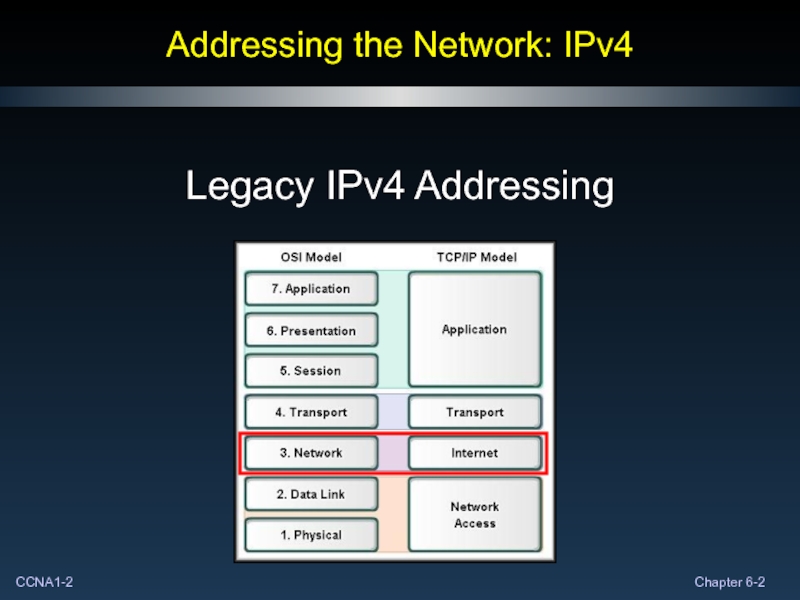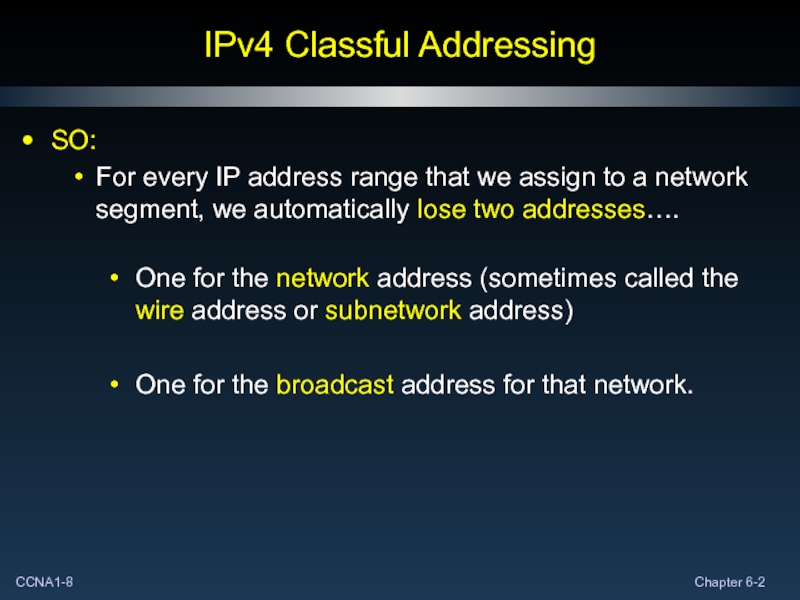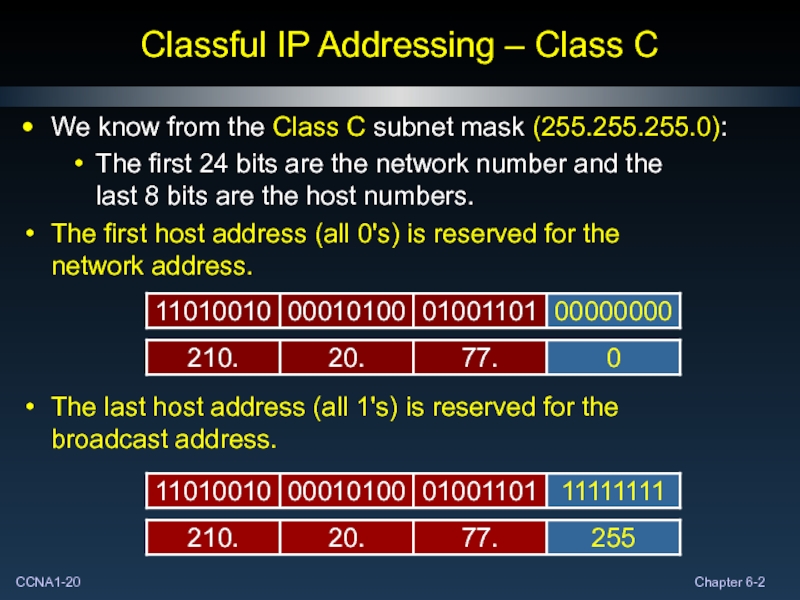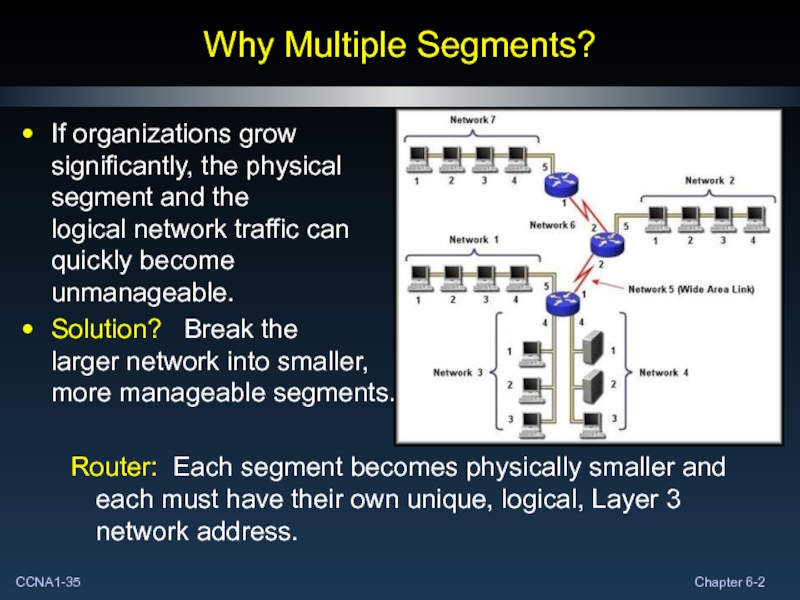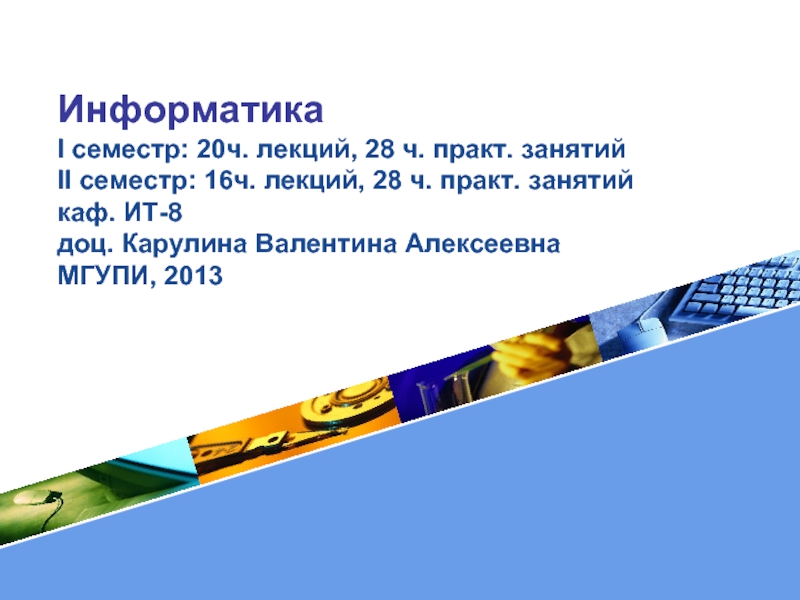- Главная
- Разное
- Дизайн
- Бизнес и предпринимательство
- Аналитика
- Образование
- Развлечения
- Красота и здоровье
- Финансы
- Государство
- Путешествия
- Спорт
- Недвижимость
- Армия
- Графика
- Культурология
- Еда и кулинария
- Лингвистика
- Английский язык
- Астрономия
- Алгебра
- Биология
- География
- Детские презентации
- Информатика
- История
- Литература
- Маркетинг
- Математика
- Медицина
- Менеджмент
- Музыка
- МХК
- Немецкий язык
- ОБЖ
- Обществознание
- Окружающий мир
- Педагогика
- Русский язык
- Технология
- Физика
- Философия
- Химия
- Шаблоны, картинки для презентаций
- Экология
- Экономика
- Юриспруденция
Addressing the Network - IPV4. Part II презентация
Содержание
- 1. Addressing the Network - IPV4. Part II
- 2. Addressing the Network: IPv4 Legacy IPv4 Addressing
- 3. Legacy IPv4 Addressing In the early 1980’s,
- 4. IPv4 Classful Addressing Devices examined the first
- 5. IPv4 Classful Addressing In a classful addressing
- 6. IPv4 Classful Addressing In the early 1990s,
- 7. IPv4 Classful Addressing Let’s quickly review…. In
- 8. IPv4 Classful Addressing SO: For every IP
- 9. IPv4 Classful Addressing Our numbers for the
- 10. IPv4 Classless Addressing The system currently in
- 11. Addressing the Network: IPv4 Calculating Addresses
- 12. Calculating Addresses Skills: To work with an
- 13. Calculating Addresses
- 14. The Network Number A host on a
- 15. The Network Number Routers use the network
- 16. The Broadcast If a host needs to
- 17. The Host Number The host number is
- 18. The Subnet Mask Subnet Mask: Let's not
- 19. Classful IP Addressing – Class C Class
- 20. Classful IP Addressing – Class C We
- 21. Classful IP Addressing – Class C Because
- 22. Classful IP Addressing – Class B Class
- 23. Classful IP Addressing – Class B We
- 24. Classful IP Addressing – Class B Because
- 25. Classful IP Addressing – Class A Class
- 26. Classful IP Addressing – Class A Class
- 27. Classful IP Addressing – Class A We
- 28. Classful IP Addressing – Class A Because
- 29. Classful IP Addressing IP Address: 130.61.22.204
- 30. Classful IP Addressing IP Address: 197.101.28.83
- 31. Classful IP Addressing IP Address: 64.133.65.101
- 32. Addressing the Network: IPv4 Basic Subnetting
- 33. IP Address Crisis The world is running
- 34. IP Address Crisis The goal, then, is
- 35. Why Multiple Segments? If organizations grow significantly,
- 36. Why Multiple Segments? This company has multiple
- 37. Why Multiple Segments? Class B 131.15.0.0 What happens here?
- 38. Why Multiple Segments? Network numbers MUST be
- 39. Creating a Subnet To subnet a network,
- 40. Creating a Subnet The borrowed bits become
- 41. Creating a Subnet The subnet mask changes
- 42. Creating a Subnet - The Rules Host
- 43. Subnets and Useable Hosts – Class C
- 44. Subnetting - Class C This is our
- 45. Subnetting - Class C Looking at the
- 46. Magic Numbers To make the job of
- 47. Subnetting - Class C Network: 192.168.80.0
- 48. Subnetting – Class C Result is 8
- 49. Subnetting – Class A or Class B
- 50. Subnetting - Class B Let's try one.
- 51. Subnetting - Class B You have decided
- 52. Subnetting - Class B Head Office + 10 Central Offices ---100 to 3,000 users each
- 53. Subnetting – Class B Determining your magic
- 54. Subnetting – Class B 172.25.255.255 15
- 55. Your turn to do STUFF!
Слайд 3Legacy IPv4 Addressing
In the early 1980’s, unicast address ranges were grouped
Each class defined:
A specifically sized network.
Specific address blocks for these networks.
Слайд 4IPv4 Classful Addressing
Devices examined the first octet of the address and
The high order bits never change for each class.
Classful Addressing:
192.168.23.2 is in the Class C range
Therefore – 24 network bits and 8 hosts bits.
Слайд 5IPv4 Classful Addressing
In a classful addressing scheme, these divisions take place
This may seem obvious now but is important to remember when we explore how to divide a single network into several smaller subnets (subnetting).
Слайд 6IPv4 Classful Addressing
In the early 1990s, the subnet mask was added
The subnet mask allowed networks to subdivided or subnetted.
Each class was assigned a default subnet mask.
Слайд 7IPv4 Classful Addressing
Let’s quickly review….
In order to function properly with network
Network Address:
All HOST BITS are set to 0.
Host Address: HOST BITS will vary.
Broadcast Address:
All HOST BITS are set to 1.
For a host to communicate directly with another host on the same network, they must have the same network portion.
Слайд 8IPv4 Classful Addressing
SO:
For every IP address range that we assign to
One for the network address (sometimes called the wire address or subnetwork address)
One for the broadcast address for that network.
Слайд 9IPv4 Classful Addressing
Our numbers for the number of hosts per network
As we will see, the formula (2number_of_bits - 2 or 2n - 2) is an important part of assigning an IP address range to a network segment.
Слайд 10IPv4 Classless Addressing
The system currently in use is classless addressing.
Address blocks
This is accomplished by subnetting with Variable Length Subnet Masking (VLSM).
To understand classless addressing, you must first understand classful addressing.
Слайд 12Calculating Addresses
Skills:
To work with an IPv4 network:
Find the network address for
Find the broadcast address for the network.
Find what host addresses are available in the network.
Divide a large network into smaller networks.
Слайд 14The Network Number
A host on a network can communicate directly with
Слайд 15The Network Number
Routers use the network number to build their routing
The IP address that indicates the network number has all 0 bits in the host portion of the IP Address.
Слайд 16The Broadcast
If a host needs to send a broadcast, it also
A broadcast address is used for that purpose only and cannot be assigned to a host.
Слайд 17The Host Number
The host number is the portion of the IP
Слайд 18The Subnet Mask
Subnet Mask:
Let's not forget about the subnet mask.
Each class
Слайд 19Classful IP Addressing – Class C
Class C:
Address range: 192 - 223
Number of
Number of networks: 2,097,152
Number of host bits: 8
Number of hosts per network:
28 = 256
Number of Useable Hosts per network:
28 - 2 = 254
Default Subnet Mask: 255.255.255.0 or /24
Слайд 20Classful IP Addressing – Class C
We know from the Class C
The first 24 bits are the network number and the last 8 bits are the host numbers.
Слайд 21Classful IP Addressing – Class C
Because the host portion of the
The number of usable host addresses for the entire network is 28 - 2 = 254
Слайд 22Classful IP Addressing – Class B
Class B:
Address range: 128 - 191
Number of
Number of networks: 16,384
Number of host bits: 16
Number of hosts per network:
216 = 65,536
Number of Useable Hosts per network:
216 - 2 = 65,534
Default Subnet Mask: 255.255.0.0 or /16
Слайд 23Classful IP Addressing – Class B
We know from the Class B
The first 16 bits are the network number and the last 16 bits are the host numbers.
Слайд 24Classful IP Addressing – Class B
Because the host portion of the
The number of usable host addresses for the entire network is 216 - 2 = 65,534
Слайд 25Classful IP Addressing – Class A
Class A:
Address range: 0 - 127
Number of
Number of networks: 126
Number of host bits: 24
Number of hosts per network:
224 = 16,777,216
Number of Useable Hosts per network:
224 - 2 = 16,777,214
Default Subnet Mask: 255.0.0.0 or /8
Слайд 26Classful IP Addressing – Class A
Class A (Usable Networks):
An address range
Network 0 is reserved for special use for default routes.
Network 127 is reserved as a loopback network.
The address 127.0.0.1 is automatically available in every device after TCP/IP has been installed.
If you "ping" that address and get a good response, it means that TCP/IP is installed correctly.
Слайд 27Classful IP Addressing – Class A
We know from the Class A
The first 8 bits are the network number and the last 24 bits are the host numbers.
Слайд 28Classful IP Addressing – Class A
Because the host portion of the
The number of usable host addresses for the entire network is 224 - 2 = 16,777,216
Слайд 29Classful IP Addressing
IP Address: 130.61.22.204 / 16
Network Address is:
Broadcast
Subnet Mask:
Number of Useable host addresses:
What are they?
Address Class:
B
130.61.0.0
255.255.0.0
130.61.255.255
216 - 2 = 65,534
130.61.0.1 - 130.61.255.254
Слайд 30Classful IP Addressing
IP Address: 197.101.28.83 / 24
Network Address is:
Broadcast
Subnet Mask:
Number of Useable host addresses:
What are they?
Address Class:
C
197.101.28.0
255.255.255.0
197.101.28.255
28 - 2 = 254
197.101.28.1 - 197.101.28.254
Слайд 31Classful IP Addressing
IP Address: 64.133.65.101 / 8
Network Address is:
Broadcast
Subnet Mask:
Number of Useable host addresses:
What are they?
Address Class:
A
64.0.0.0
255.0.0.0
64.255.255.255
224 - 2 = A Bunch!
64.0.0.1 - 64.255.255.254
Слайд 33IP Address Crisis
The world is running short of available IP addresses.
If
The number of organizations would be limited and many IP addresses would be wasted.
e.g. An organization with 256 hosts owns a Class B address. 65,000 addresses not used.
Owning an address means that the organization has applied for and received that address range from the IANA.
Слайд 34IP Address Crisis
The goal, then, is to use owned addresses (or
Subnetting
CIDR
Network Address Translation (NAT).
It is also desirable to avoid waste within the organization when using private IP addressing.
Careful planning of the addressing scheme is key to a successful implementation.
Слайд 35Why Multiple Segments?
If organizations grow
significantly, the physical
segment and the
logical network traffic
Solution? Break the larger network into smaller, more manageable segments.
Router: Each segment becomes physically smaller and each must have their own unique, logical, Layer 3 network address.
Слайд 36Why Multiple Segments?
This company has multiple networks connected by a router.
The company IT headquarters has assigned a Class B address of
131.15.0.0
to use for ALL these networks.
Слайд 38Why Multiple Segments?
Network numbers MUST be unique.
You should:
Plan what you need.
Plan
Make efficient use of addresses.
131.15.1.0
131.15.3.0
131.15.4.0
131.15.5.0
131.15.2.0
131.15.6.0
131.15.7.0
Subnetting
Слайд 39Creating a Subnet
To subnet a network, the IP address host portion
Bits are borrowed from the host portion and assigned to the network portion to create a new network address.
The new network address covers a smaller portion of the original network number.
It is a sub-network of the original or a subnet.
Слайд 40Creating a Subnet
The borrowed bits become part of the network portion
The remaining host bits become the host portion and are used to identify individual network hosts and create broadcasts for the new subnet.
Слайд 41Creating a Subnet
The subnet mask changes to reflect the new network/host
The same subnet mask applies to ALL networks derived from the subnetting process.
Original Subnet Mask: 255.255.0.0 11111111.11111111.00000000.00000000
Borrow 8 bits: 11111111.11111111.11111111.00000000
New Subnet Mask: 255.255.255.0
Слайд 42Creating a Subnet - The Rules
Host bits must be borrowed in
A minimum of two bits must remain for host addresses.
A remaining host mask of all 0's or all 1's cannot be assigned as a host address.
To determine the number of subnets or hosts:
Subnets: 2number_of_borrowed_host_bits
Usable Hosts Per Subnet: 2number_of_remaining_host_bits - 2
Слайд 43Subnets and Useable Hosts – Class C
Default: 255.255.255.0 - 24 network
Leave at least 2
Слайд 44Subnetting - Class C
This is our network and
we have decided to
We need 4 networks with addresses for 5 hosts and want to leave room for some future expansion.
Слайд 45Subnetting - Class C
Looking at the table, we
see that borrowing 3
bits
This choice meets the current requirements and leaves room for expansion.
Слайд 46Magic Numbers
To make the job of subnetting easier,
there is a method
The magic number we're looking for is the number of addresses in each network, including the network, broadcast and host range.
The calculation 2number_ of_ host_ bits yields the "magic" number.
We have 5 host bits remaining so…..
25 = 32 - our "magic" number.
Слайд 47Subnetting - Class C
Network: 192.168.80.0 Subnet Mask: 255.255.255.224
Network: 27
192.168.80.255
192.168.80.225 – 192.168.80.254
192.168.80.224
7
192.168.80.223
192.168.80.193 – 192.168.80.222
192.168.80.192
6
192.168.80.191
192.168.80.161 – 192.168.80.190
192.168.80.160
5
192.168.80.159
192.168.80.129 – 192.168.80.158
192.168.80.128
4
192.168.80.127
192.168.80.97 – 192.168.80.126
192.168.80.96
3
192.168.80.95
192.168.80.65 – 192.168.80.94
192.168.80.64
2
192.168.80.63
192.168.80.33 – 192.168.80.62
192.168.80.32
1
192.168.80.31
192.168.80.1 – 192.168.80.30
192.168.80.0
0
Broadcast Address
Subnet Address
Range
Network
Address
ID
Слайд 48Subnetting – Class C
Result is 8 subnets with 30 useable hosts
Allows the expansion of hosts in each network and the addition of two more networks without changing our IP Addressing scheme.
192.168.80.0/27
192.168.80.32/27
192.168.80.64/27
192.168.80.96/27
Слайд 49Subnetting – Class A or Class B
The subnetting process for class
Determine what is required.
Number of networks and number of hosts per network.
Determine the number of bits to be borrowed.
Determine your magic number.
Subnet to produce the ranges for each subnetwork.
Слайд 50Subnetting - Class B
Let's try one.
You are the network administrator for
You have 10 world-wide central offices and each of those have their own networks and branch offices. Central and Branch office networks range from 100 to 3,000 users.
You have decided that a Class B network will be sufficient for your needs and you must subnet the network to include yourself and the central offices.
Each central office handles their own network maintenance and it will be up to them to further subnet the network you design.
Слайд 51Subnetting - Class B
You have decided to use the Class B
172.25.0.0 / 16
Head Office
Central 01
Central 02
Central 03
Central 10
Branch 01
Branch nn
Your objective is to provide enough addresses so that each central office can cover their branches and allow room for future expansion.
Слайд 53Subnetting – Class B
Determining your magic number – Class A and
The trick here in determining the magic number is to only work with the remaining host bits up to a total of 8.
The rest of the bits will fall in line as host bits.
e.g.
Borrow 4 bits – subnet mask 255.255.240.0
11111111.11111111.11110000.00000000
4 remaining host bits:
11111111.11111111.11110000.00000000
Magic Number = 24 = 16
Слайд 54Subnetting – Class B
172.25.255.255
15
14
13
12
11
10
9
8
7
6
5
4
172.25.63.255
172.25.48.1 to 172.25.63.254
172.25.48.0
3
172.25.47.255
172.25.32.1 to 172.25.47.254
172.25.32.0
2
172.25.31.255
172.25.16.1 to 172.25.31.254
172.25.16.0
1
172.25.15.255
172.25.0.1
172.25.0.0
0
Broadcast
Address
Subnet Address
Range
Network Address
ID

